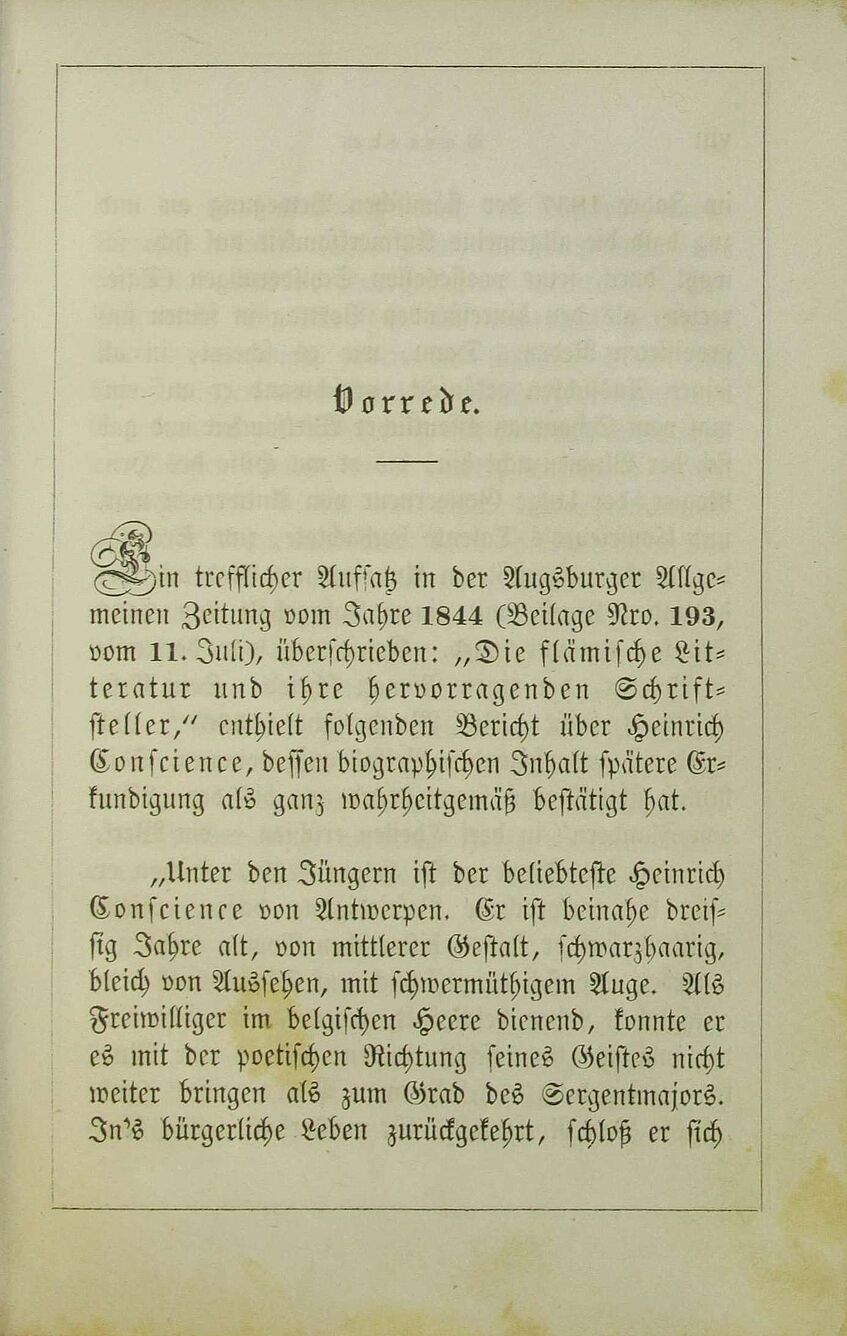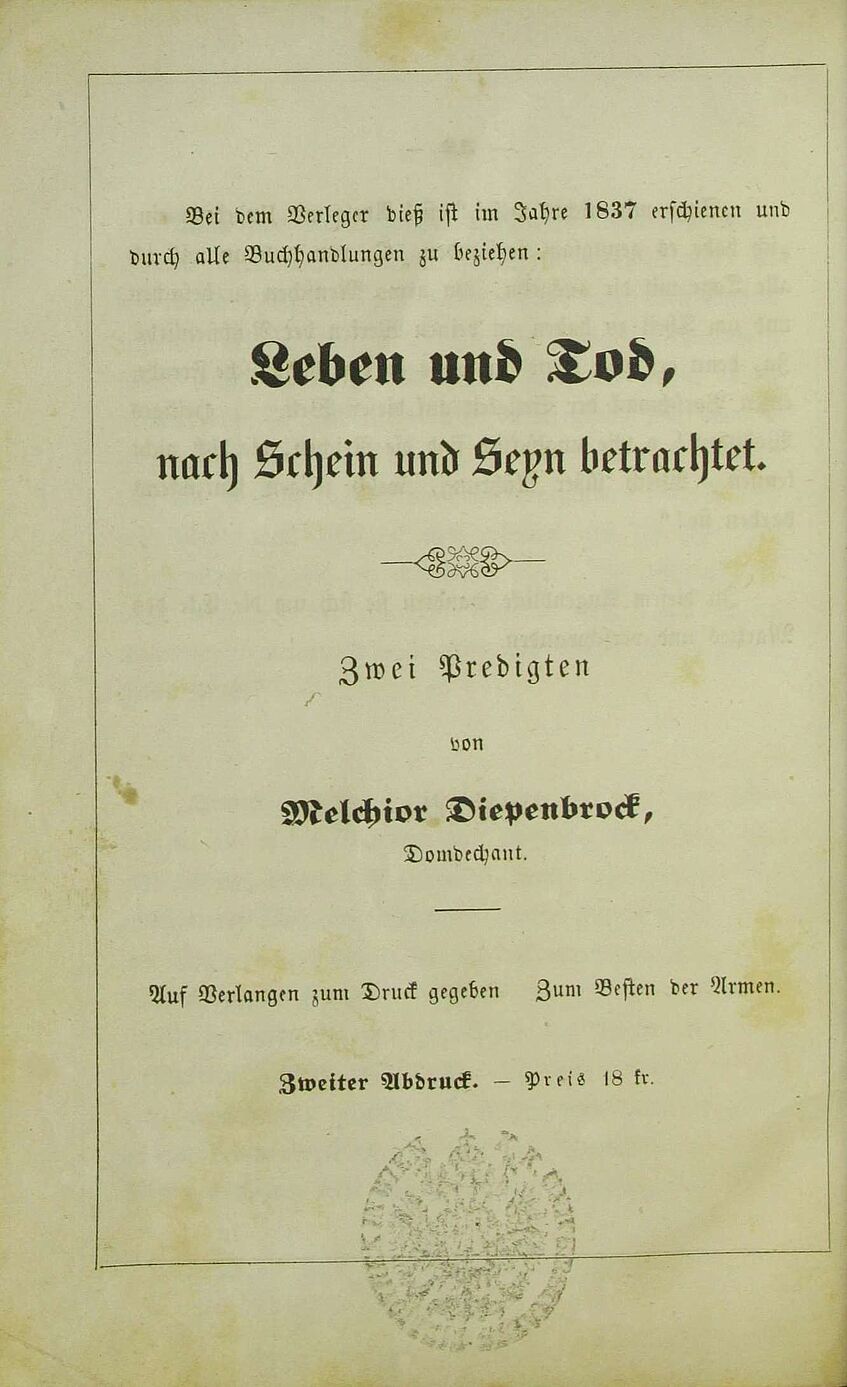Preface
Preface
Flämisches Stillleben is not just the German translation of an existing collection of tales by Hendrik Conscience. Translator Melchior von Diepenbrock also assembled three separate publications into one volume and gave it the title Flämisches Stillleben. Von Diepenbrock’s choice of title seems to be inspired by an article in the supplement of the Allgemeine Zeitung (11/07/1844) on the writers of the Flemish Movement, which Von Diepenbrock quotes extensively in his preface to Flämisches Stillleben. In the article, Conscience's Antwerp novellas are described as “Skizzen aus dem alltäglichen Leben”. Wat eene moeder lijden kan and Hoe men schilder wordt are furthermore praised as “ächt niederländischen Genreschilderungen” (1540). Von Diepenbrock also borrows a term from the visual arts and names his collection of translations after one of the most famous painting traditions from the Low Countries; the still life.
In his preface to Flämisches Stillleben, Von Diepenbrock justifies his translations of the still largely unknown Belgian author by referring to the appraisal in the Allgemeine Zeitung, which was at that time one of the leading German-language newspapers, with contributors like Heinrich Schliemann, Heinrich Heine, and Richard Wagner. Von Diepenbrock also mentions the judgment of his friends, who considered the stories to be instructive and useful (Diepenbrock von X). Moreover, the translator suggests a cultural affinity between the audiences in Belgium and in the German-speaking area by describing Conscience's stories as homely and familiar (Diepenbrock von XI).
In other passages, Von Diepenbrock presents German culture as an inspiration for Conscience and his works, for example in his announcement of Conscience’s next publication Eenige bladzyden uit het boek der natuer (1846) as inspired by German research, especially by Goethe’s botanical writings. This framing is supported through a quote from Conscience. In a letter to Von Diepenbrock, Conscience describes himself as a son “der großen deutschen Familie, der sich niederdeutsch ausdrückt, um so auf seine Brüder einzuwirken, sie der überwiegenden Herrschaft der Kelten zu entziehen und ihre Blicke auf das große Vaterland der Arminius hinzuleiten, von wo heute das Licht leuchtet“ (Diepenbrock von X–XI). Conscience is also quoted describing the French cultural influence as a threat to the Flemish language and culture. This way Conscience explains the anti-French elements in his works, which may seem a little glaring to German readers, as he presumes. Nevertheless, Von Diepenbrock sees Conscience’s nationalist attitude as another reason why his works could be interesting to a German audience.
To heighten the interest of his readers, the translator mentions the truthfulness of the stories, which are presented as based upon true events and real persons. He also points out the impact of Conscience’s tales on the Flemish audience. According to Von Diepenbrock, characters from works like Siska van Roosemael or Hoe men schilder wordt have already attained a proverbial status in Antwerp; “so daß man von einem Kinde, welches Kunstanlage verräth, häufig hören kann: “wahrhaftig, es ist ein Fränzchen!” und von einer eiteln, putz- und gefallsüchtigen, über ihren Stand hinausstrebenden Bürgerstochter das verächtliche: “eine rechte Siska!” (Diepenbrock von XII)
Reading for Charity
Reading for Charity
A paratextual feature that sets Flämisches Stillleben apart from its source texts as well as its later translations is its ‘charity framing’. As the bishop of Breslau, Von Diepenbrock was involved in several charitable organizations. Like the proceeds of Von Diepenbrock's collection of sermons advertised on the last page of the book (Leben und Tod, nach Schein und Seyn betrachtet, Regensburg 1837), the proceeds of his Conscience translations were to go to the poor. In his preface, Von Diepenbrock links the charitable deed of buying his book to the plot of the last story Wat eene moeder lijden kan, in which two wealthy women help out a poor family in need. Not only through their imagination, but through “wirkliche thätige Teilnahme” the readers would accompany Anna and her friend Adele in their charity work, and for that, God would bless them (Diepenbrock von XIII).
Select Bibliography
Diepenbrock von, Melchior, translator. “Vorrede.” Flämisches Stillleben, in drei kleinen Erzählungen, Friedrich Pustet, 1845, pp. VII–XIV.
“Die Flämische Litteratur Und Ihre Hervorragenden Schriftsteller.” Augsburger Allgemeine Zeitung, 11 July 1844, pp. 1539–40.


